D-link AC1200 DSL-3782 User Manual
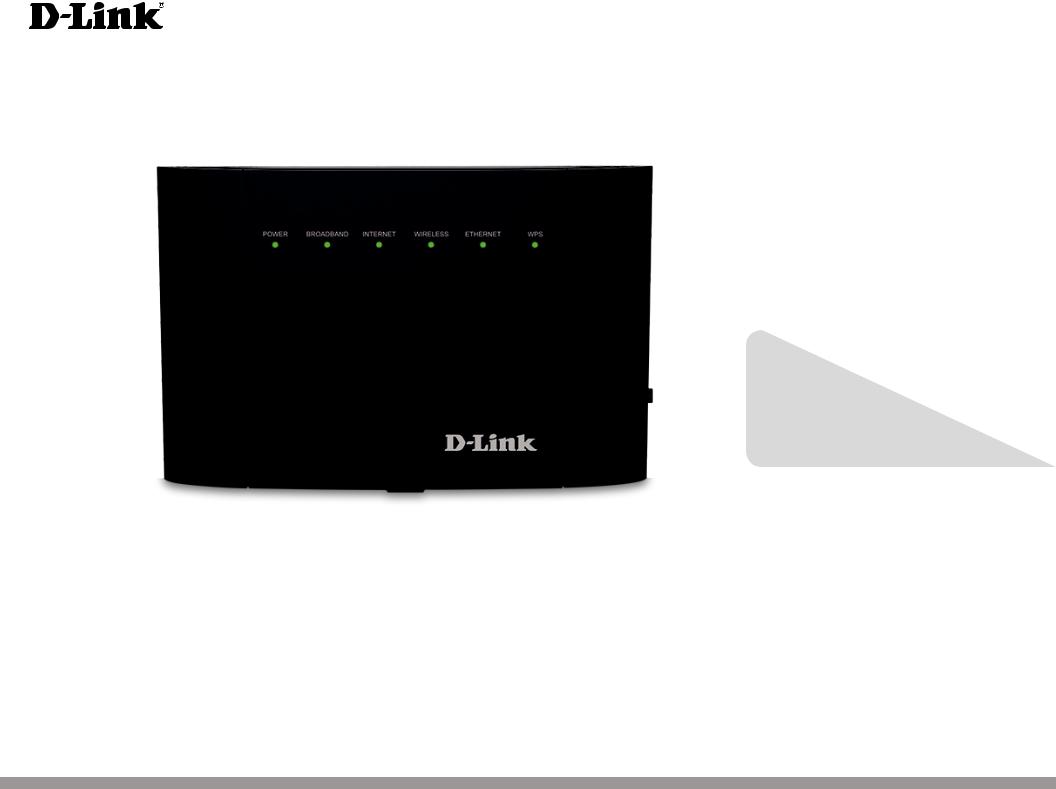
Version 1.00 | 07/07/2016
User Manual
Wireless AC1200 Dual-Band Gigabit ADSL2+/VDSL2
Modem Router
DSL-3782

Preface
D-Link reserves the right to revise this publication and to make changes in the content hereof without obligation to notify any person or organization of such revisions or changes.
Manual Revisions
Revision |
Date |
Description |
1.00 |
June 16, 2016 |
Initial release |
|
|
|
Trademarks
D-Link and the D-Link logo are trademarks or registered trademarks of D-Link Corporation or its subsidiaries in the United States or other countries. All other company or product names mentioned herein are trademarks or registered trademarks of their respective companies.
Apple®, Apple logo®, Safari®, iPhone®, iPad®, iPod touch® and Macintosh® are trademarks of Apple Inc., registered in the U.S. and other countries. App StoreSM is a service mark of Apple Inc.
Chrome™ browser, Google Play™ and Android™ are trademarks of Google Inc.
Internet Explorer®, Windows® and the Windows logo are trademarks of the Microsoft group of companies. Copyright © 2016 by D-Link Corporation, Inc.
All rights reserved. This publication may not be reproduced, in whole or in part, without prior expressed written permission from D-Link Corporation, Inc.
ErP Power Usage
This device is an Energy Related Product (ErP) with High Network Availability (HiNA), and automatically switches to a power-saving Network Standby mode within 1 minute of no packets being transmitted. It can also be turned off through a power switch to save energy when it is not needed.
Network Standby: 4.761watts Switched Off: 0.1878 watts
D-Link DSL-3782 User Manual |
i |

Table of Contents
Table of Contents
Preface.................................................................................. |
i |
Product Overview.............................................................. |
1 |
Package Contents......................................................................... |
1 |
System Requirements.................................................................. |
2 |
Introduction.................................................................................... |
3 |
Features............................................................................................ |
4 |
Hardware Overview...................................................................... |
5 |
Back Panel................................................................................ |
5 |
Side Panel................................................................................. |
6 |
LEDs............................................................................................ |
7 |
Installation.......................................................................... |
8 |
Before you Begin........................................................................... |
8 |
Wireless Installation Considerations...................................... |
9 |
Manual Setup............................................................................... |
10 |
Getting Started................................................................. |
12 |
Setup Wizard................................................................................. |
13 |
Configuration................................................................... |
19 |
Home............................................................................................... |
19 |
Internet................................................................................... |
20 |
IPv4...................................................................................... |
21 |
DSL....................................................................................... |
22 |
D-Link...................................................................................... |
23 |
Connected Clients............................................................... |
24 |
USB Device............................................................................. |
25 |
Settings........................................................................................... |
26 |
Wizard...................................................................................... |
26 |
Internet................................................................................... |
26 |
ADSL.................................................................................... |
27 |
VDSL.................................................................................... |
29 |
WAN Settings................................................................... |
30 |
Dynamic IP (DHCP)................................................... |
30 |
Static IP......................................................................... |
31 |
PPPoE............................................................................ |
32 |
PPPoA............................................................................ |
34 |
Bridge Mode............................................................... |
35 |
Wireless................................................................................... |
36 |
Advanced Settings.............................................................. |
37 |
Guest Zone....................................................................... |
43 |
Network.................................................................................. |
44 |
USB........................................................................................... |
47 |
Features.......................................................................................... |
48 |
Firewall.................................................................................... |
48 |
Application............................................................................ |
49 |
ACL............................................................................................ |
50 |
Port Forwarding................................................................... |
51 |
DMZ (Exposed Host)...................................................... |
53 |
IP/MAC Filtering................................................................... |
54 |
IP Filter................................................................................ |
54 |
MAC Filter.......................................................................... |
56 |
Static Route........................................................................... |
57 |
D-Link DSL-3782 User Manual |
ii |

Table of Contents
Dynamic DNS........................................................................ |
58 |
IGMP......................................................................................... |
59 |
Web Filter............................................................................... |
60 |
Management................................................................................ |
61 |
Time & Schedule.................................................................. |
61 |
Time..................................................................................... |
61 |
Schedule............................................................................ |
62 |
Log Info................................................................................... |
63 |
System Log....................................................................... |
64 |
System Settings................................................................... |
65 |
Admin................................................................................. |
66 |
Firmware Upgrade.............................................................. |
67 |
Statistics.................................................................................. |
68 |
Diagnostics............................................................................ |
69 |
Connect and Share a USB Device.................................... |
70 |
Connect and Share a USB Storage Device......................... |
70 |
Connecting from a Windows-Based PC....................... |
71 |
Connecting from a Mac..................................................... |
76 |
Connect a Wireless Client to Your Router....................... |
80 |
WPS Button................................................................................... |
80 |
Windows® 10................................................................................. |
81 |
Windows® 8................................................................................... |
83 |
WPA/WPA2............................................................................. |
83 |
Windows® 7................................................................................... |
85 |
WPA/WPA2............................................................................. |
85 |
WPS.......................................................................................... |
87 |
Windows Vista®............................................................................ |
91 |
WPA/WPA2............................................................................. |
92 |
Troubleshooting............................................................... |
94 |
Wireless Basics.................................................................. |
98 |
What is Wireless?......................................................................... |
99 |
Tips................................................................................................ |
101 |
Wireless Modes......................................................................... |
102 |
Networking Basics.......................................................... |
103 |
Check your IP address............................................................. |
103 |
Statically Assign an IP address............................................. |
104 |
Wireless Security.......................................................... |
105 |
What is WPA?................................................................. |
105 |
Technical Specifications................................................. |
106 |
Regulatory Statements.................................................. |
107 |
D-Link DSL-3782 User Manual |
iii |

Section 1 - Product Overview
ProductPackageOverviewContents
DSL-3782 Wireless AC1200 Dual-Band ADSL2+/VDSL2 Modem Router
Power Adapter
Ethernet Cable
Phone Cable
If any of the above items are missing, please contact your reseller.
Note: Using a power supply other than the one included with the DSL-3782 may cause damage and void the warranty for this product.
D-Link DSL-3782 User Manual |
1 |
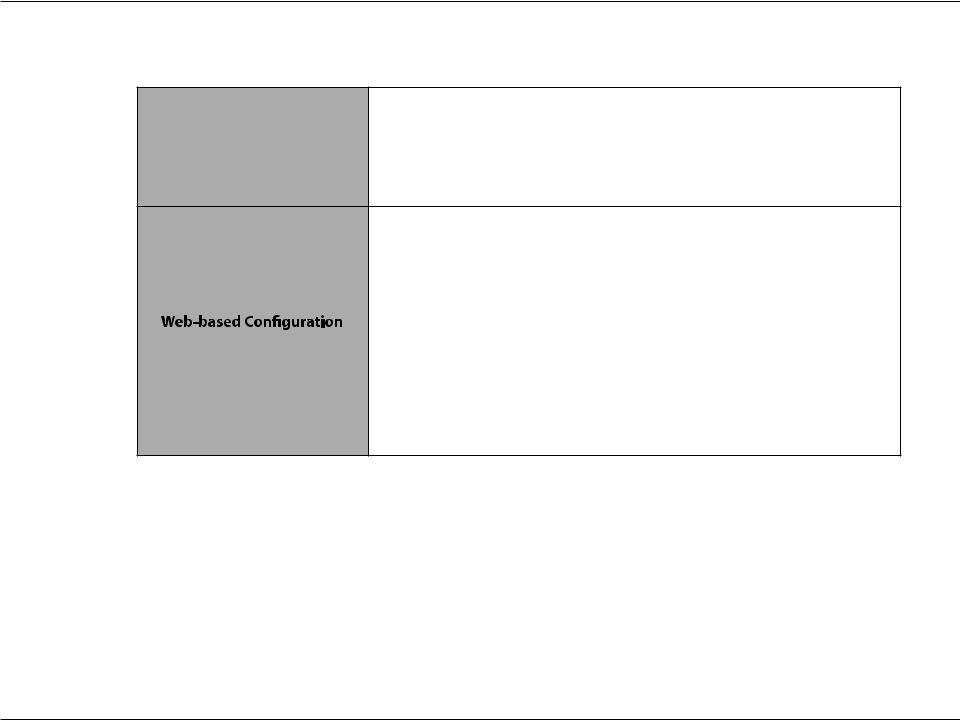
Section 1 - Product Overview
System Requirements
• An active subscription with an Internet Service Provider using one of the following connection types:
Network Requirements • A VDSL/ADSL connection to a telephone line using the DSL port
• An 802.11ac/n/g/b/a wireless or Ethernet port
Computer with the following:
•Microsoft Windows® 10/8/7/Vista/XP SP3 or Mac with OS X 10.7 or higher
•An installed Ethernet adapter
|
Browser Requirements: |
|
|
• Internet Explorer 8 or higher |
|
Utility Requirements |
• EDGE Browser 20 or higher |
|
• Firefox 20 or higher |
||
|
||
|
• Safari 4 or higher |
|
|
• Chrome 17 or higher |
Windows® Users: Make sure you have the latest version of Java installed. Visit
www.java.com to download the latest version.
D-Link DSL-3782 User Manual |
2 |
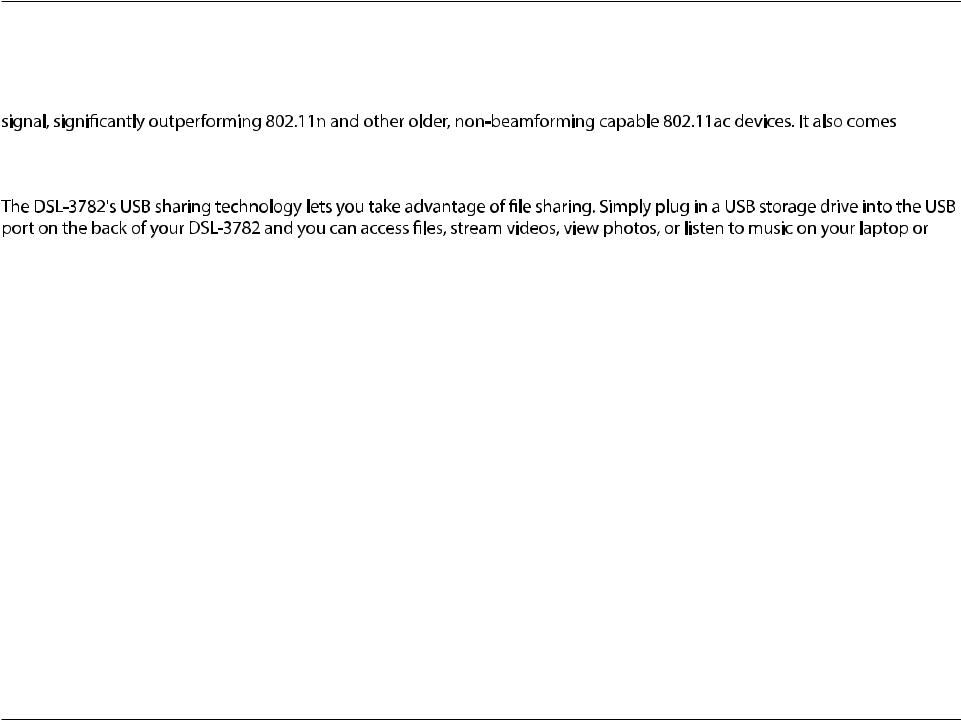
Section 1 - Product Overview
Introduction
The D-Link DSL-3782 Wireless AC1200 Dual-Band ADSL2+/VDSL2 Modem Router shares your DSL Internet connection over blazing fast Wireless AC, and uses advanced AC beamforming technology to maximize the speed and range of your wireless
equipped with a USB port, and four Fast Ethernet 10/100 ports.
mobile devices. The intuitive interface lets anyone immediately connect to a variety of entertainment options stored securely on your own storage device.
The DSL-3782 provides incredible speeds, smart antenna technology, fast ports, and robust security features.
D-Link DSL-3782 User Manual |
3 |

Section 1 - Product Overview
Features
•Faster Wireless Networking - The DSL-3782 is dual-band capable of up to a full 1200 Mbps* for you wireless devices. It operates on both the 2.4 GHz and 5 GHz bands to allow separation of traffic so users can participate in high-bandwidth activities, such as video streaming, online gaming, and real-time audio, without affecting low-priority traffic like email and web surfing.
•Compatible with 802.11n/g/b/a Devices - The DSL-3782 is still fully backwards compatible with the 802.11n, 802.11g, and 802.11a standards, so it can connect with existing 802.11n, 802.11g, 802.11b, and 802.11a wireless devices.
•Advanced Features - The web-based user interface displays a number of advanced network management features including:
•Filtering - Easily apply content filtering based on IP address, MAC address, URL, and/or domain name.
•Scheduling - The firewall, wireless, and port forwarding features can be scheduled to be active on a schedule you define.
•User-friendly Setup Wizard - Through its easy-to-use web-based user interface, the DSL-3782 lets you control what information is accessible to those on the wireless network, whether from the Internet, or from your company’s server. Configure your router to your specific settings within minutes.
*Maximum wireless signal rate derived from IEEE Standard 802.11a, 802.11b, 802.11g, 802.11n, and 802.11ac specifications. Actual data throughput will vary. Network conditions and environmental factors, including volume of network traffic, building materials and construction, and network overhead, lower actual data throughput rate. Environmental conditions will adversely affect wireless signal range.
D-Link DSL-3782 User Manual |
4 |
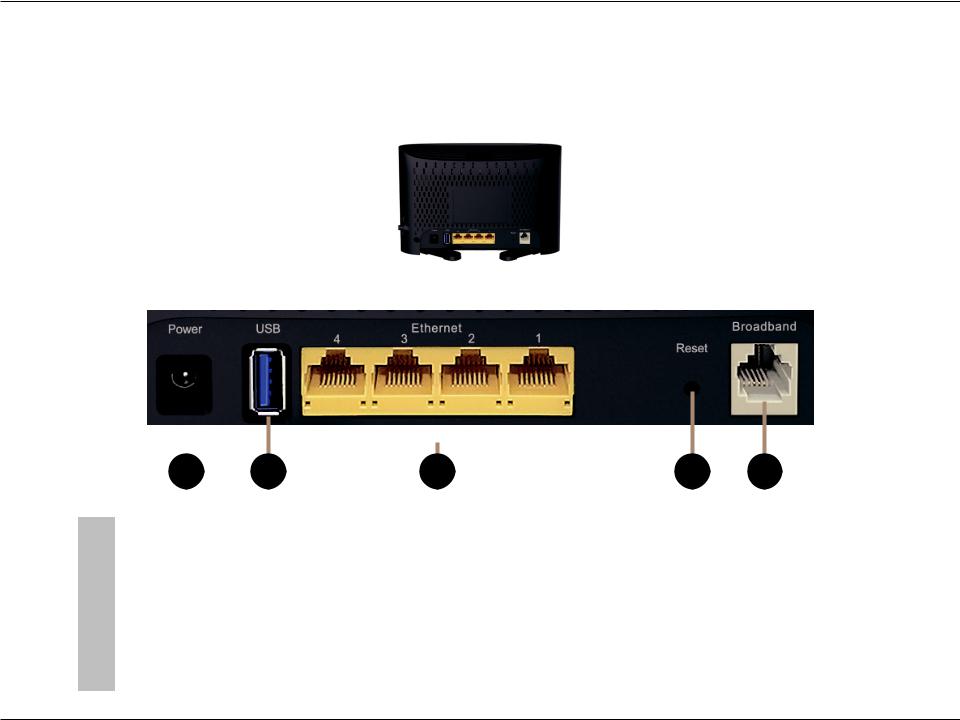
Section 1 - Product Overview
Hardware Overview
Back Panel
|
|
|
|
|
|
|
|
|
|
|
|
|
|
|
|
|
|
|
|
|
|
|
|
|
|
|
|
|
|
|
|
|
|
|
|
|
|
|
|
|
|
|
|
|
|
|
|
|
|
|
|
|
|
|
|
|
|
|
|
|
|
|
|
|
|
|
|
|
|
|
|
|
|
|
|
|
|
|
|
|
|
|
|
|
|
|
|
|
|
|
|
|
|
|
|
|
|
|
|
|
|
|
|
|
|
|
|
|
|
|
|
|
|
|
|
|
|
|
|
|
|
|
|
|
|
|
|
|
|
|
|
|
|
|
|
|
|
|
|
|
|
|
|
|
|
|
|
|
|
|
|
|
|
|
|
|
|
|
|
|
|
|
|
|
|
|
|
|
|
|
|
|
|
|
|
|
|
|
|
|
|
|
|
|
|
|
|
||
|
1 |
2 |
3 |
|
|
|
|
4 |
5 |
|
|
|||||||
|
|
|
|
|||||||||||||||
|
|
|
|
|
|
|
|
|
|
|
|
|
|
|
|
|
|
|
1 |
Power Connector |
Connector for the supplied power adapter. |
|
|
|
|
||||||||||||
|
|
|
|
|
|
|
|
|
|
|
|
|
|
|
|
|
|
|
2 |
|
|
USB 2.0 Port |
|
Connects to USB flash drives to share content. |
|
|
|
|
|||||||||
|
|
|
|
|
|
|
|
|
|
|
|
|
|
|
|
|
|
|
3 |
|
LAN Ports (1-4) |
|
Connects to Ethernet devices such as computers, switches, storage (NAS) devices and |
||||||||||||||
|
|
game consoles. |
|
|
|
|
||||||||||||
|
|
|
|
|
|
|
|
|
|
|
||||||||
|
|
|
|
|
|
|
|
|
|
|
|
|
|
|
|
|
|
|
4 |
|
|
Reset Button |
|
To reset the device to its factory default settings, use a paper clip to press and hold the |
|||||||||||||
|
|
|
reset button for 5 seconds. |
|
|
|
|
|||||||||||
|
|
|
|
|
|
|
|
|
|
|
||||||||
|
|
|
|
|
|
|
|
|
|
|
|
|
|
|
|
|
|
|
5 |
|
|
DSL Port |
|
Connects to an DSL-enabled telephone line. |
|
|
|
|
|||||||||
|
|
|
|
|
|
|
|
|
|
|
|
|
|
|
|
|
|
|
D-Link DSL-3782 User Manual |
5 |
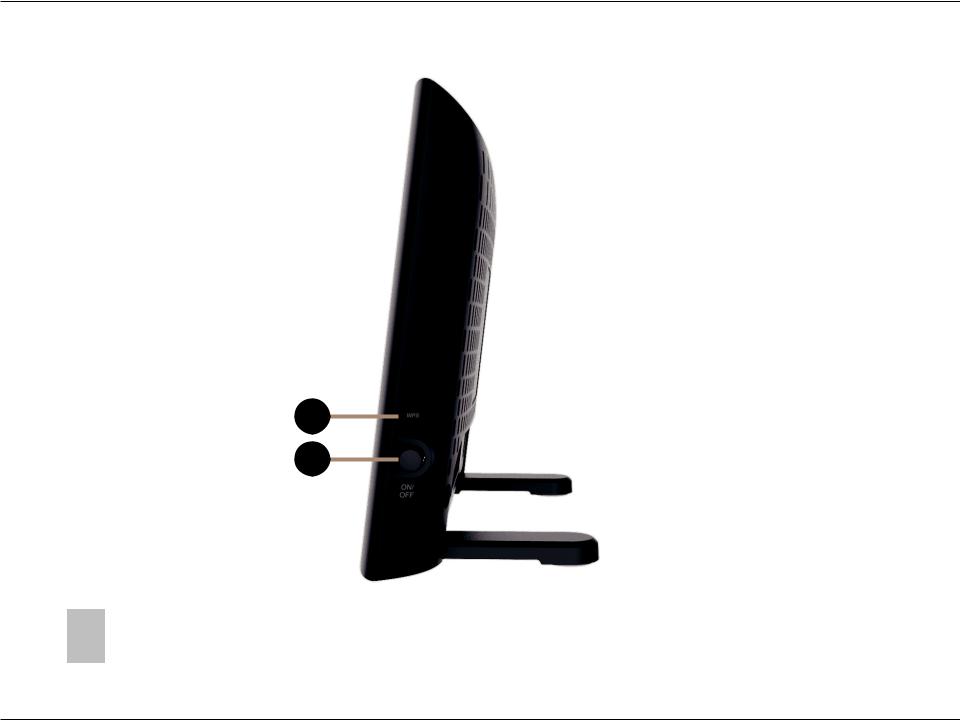
Section 1 - Product Overview
Side Panel
1
2
1 |
WPS Button |
Press to start the WPS process and automatically create a secure connection to a WPS client. |
|
|
|
2 |
Power Button |
Press the power button to power the DSL-3782 on and off. |
|
|
|
D-Link DSL-3782 User Manual |
6 |
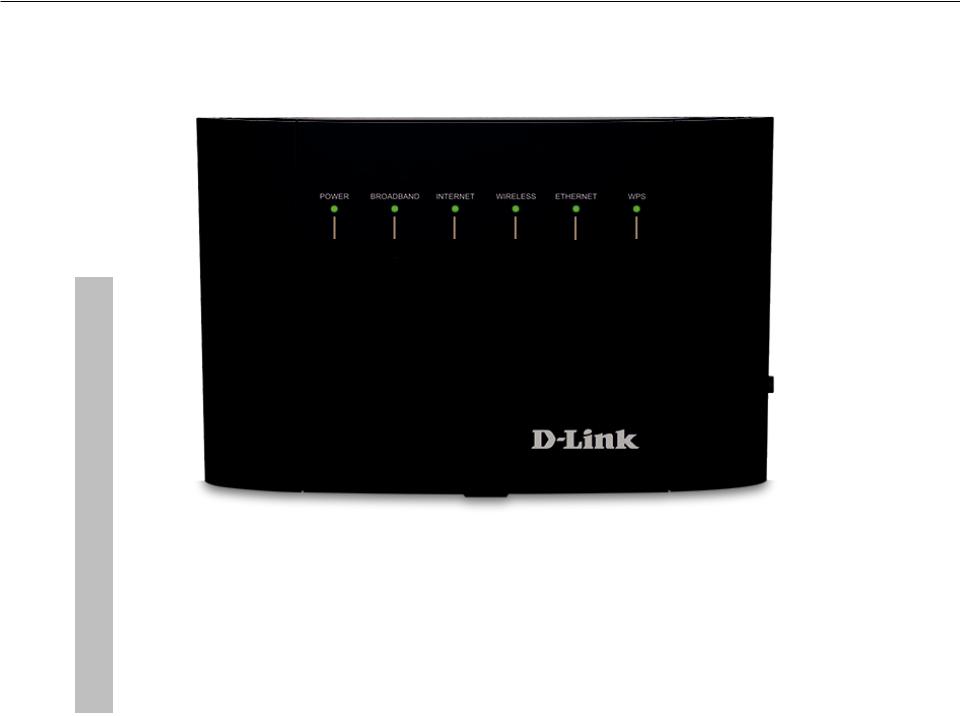
Section 1 - Product Overview
Hardware Overview
LEDs
|
|
|
|
1 |
2 |
3 |
4 |
5 |
6 |
|
|
|
|
|
|
|
|||||
|
1 |
Power |
Solid Green |
A solid green light indicates the device is powered on and working properly. |
|
|||||
|
|
|
|
|
|
|
|
|
||
Solid Red |
A solid red light indicates that the device is booting or an error has occurred. |
|
||||||||
|
|
|
|
|||||||
|
|
|
|
|
|
|||||
|
|
|
Solid Green |
A solid green light indicates a proper connection to a DSL-enabled telephone line. |
|
|||||
|
2 |
Broadband |
|
|
|
|||||
|
Blinking Green |
A blinking green light indicates the DSL port is negotiating a connection. |
|
|||||||
|
|
|
|
|
|
|||||
|
|
|
Off |
An unlit light indicates no connection to a DSL enabled-telephone line. |
|
|||||
|
|
|
|
|
|
|||||
|
|
|
Solid Green |
A solid green light indicates an Internet connection. |
|
|||||
|
|
|
|
|
|
|||||
|
3 |
Internet |
Blinking Green |
A blinking green light indicates Internet activity. |
|
|||||
|
|
|
|
|
|
|
|
|
||
Solid Red |
A solid red light indicates a PPP or DHCP failure. Check your username and password. |
|
||||||||
|
|
|
|
|||||||
|
|
|
|
|
|
|||||
|
|
|
Off |
An unlit light indicates there is no broadband connection available, or the Internet |
|
|||||
|
|
|
connection attempt timed out. |
|
|
|
||||
|
|
|
|
|
|
|
||||
|
|
|
Solid Green |
A solid green light indicates that the 2.4/5 GHz wireless networks are enabled. |
|
|||||
|
4 |
Wireless |
|
|
|
|||||
|
Blinking Green |
A blinking green light indicates wireless activity. |
|
|||||||
|
|
|
|
|
|
|||||
|
|
|
Off |
An unlit light indicates that the wireless functionality is disabled. |
|
|||||
|
|
|
|
|
|
|||||
|
|
|
Solid Green |
A solid green light indicates a device is connected to the respective LAN port. |
|
|||||
|
5 |
Ethernet |
|
|
|
|||||
|
Blinking Green |
A blinking green light indicates LAN port activity. |
|
|||||||
|
|
|
|
|
|
|||||
|
|
|
Off |
An unlit light indicates that no Ethernet devices are connected. |
|
|||||
|
|
|
|
|
|
|||||
|
6 |
WPS |
Blinking Green |
A blinking green light indicates the WPS process is active. |
|
|||||
|
|
|
|
|
|
|
|
|
|
|
|
|
|
|
|
|
|
|
|
|
|
D-Link DSL-3782 User Manual |
|
|
|
|
|
|
7 |
|||

Section 2 - Installation
Installation
This section will walk you through the installation process. Placement of the router is very important. Do not place the router in an enclosed area such as a closet, cabinet, attic, or garage.
Note: This installation section is written for users who are setting up their home Internet service with the DSL-3782 Wireless AC1200 Dual-Band Gigabit ADSL2+/VDSL2 Modem Router for the first time. If you are replacing an existing DSL modem and/or router, you may need to modify these steps.
Before you Begin
•Make sure to have your DSL service information provided by your Internet Service Provider handy. This information is likely to include your DSL account's username and password. Your ISP may also supply you with additional WAN configuration settings which are necessary to establish a connection. This information may include the connection type (DHCP IP, Static IP, PPPoE, or PPPoA) and/or ATM PVC details.
•If you are connecting a considerable amount of networking equipment, it may be a good idea to take the time to label each cable or take a picture of your existing setup before making any changes.
•We suggest setting up your DSL-3782 from a single device and verifying that it is connected to the Internet before connecting additional devices.
•If you have DSL and are connecting via PPPoE, make sure you disable or uninstall any PPPoE connection software such as WinPoET, BroadJump, or EnterNet 300 from your computer as the DSL-3782 will be providing this functionality.
D-Link DSL-3782 User Manual |
8 |

Section 2 - Installation
Wireless Installation Considerations
The D-Link wireless router lets you access your network using a wireless connection from virtually anywhere within the operating range of your wireless network. Keep in mind that the number, thickness and location of walls, ceilings, or other objects that the wireless signals must pass through may limit the range. Typical ranges vary depending on the types of materials and background RF (radio frequency) noise in your home or business. The key to maximizing wireless range is to follow these basic guidelines:
1.Keep the number of walls and ceilings between the D-Link router and other network devices to a minimum - each wall or ceiling can reduce your adapter’s range from 3 to 90 feet (1 to 30 meters.) Position your devices so that the number of walls or ceilings is minimized.
2.Be aware of the direct line between network devices. A wall that is 1.5 feet (0.5 meters) thick, at a 45-degree angle appears to be almost 3 feet (1 meter) thick. At a 2-degree angle it looks over 42 feet (14 meters) thick! Position devices so that the signal will travel straight through a wall or ceiling (instead of at an angle) for better reception.
3.Building materials make a difference. A solid metal door or aluminum studs may have a negative effect on range. Try to position access points, wireless routers, and computers so that the signal passes through drywall or open doorways. Materials and objects such as glass, steel, metal, walls with insulation, water (fish tanks), mirrors, file cabinets, brick, and concrete will degrade your wireless signal.
4.Keep your product away (at least 3 to 6 feet or 1 to 2 meters) from electrical devices or appliances that generate RF noise.
5.If you are using 2.4 GHz cordless phones or X-10 (wireless products such as ceiling fans, lights, and home security systems), your wireless connection may degrade dramatically or drop completely. Make sure your 2.4 GHz phone base is as far away from your wireless devices as possible. The base transmits a signal even if the phone is not in use.
D-Link DSL-3782 User Manual |
9 |
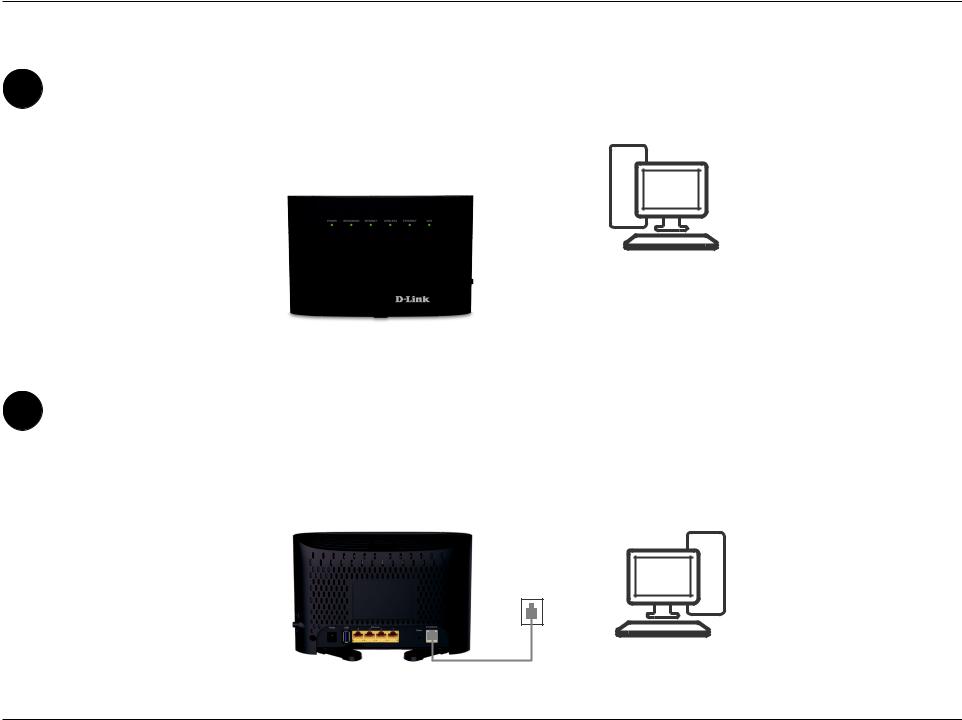
Section 2 - Installation
|
Manual Setup |
1 |
Position your DSL-3782 near your PC and a telephone wall jack which provides DSL service. Keep the modem router in |
an open area for better wireless coverage. |
|
|
|
|
|
|
|
|
|
PC |
|
|
|
|
|
|
|
|
|
|
|
|
|
|
|
|
|
|
|
|
|
Phone |
||||||||
|
DSL-3782 |
||||||||
2 |
Plug one end of the supplied DSL phone cable into the DSL port on the back of the modem router, and the other end |
||||||||
into the telephone wall jack. |
|||||||||
Note: If a DSL microsplitter/microfilter is included in the package contents, install it in line with your telephone wall jack.
PC
DSL-3782 Phone
D-Link DSL-3782 User Manual |
10 |

Section 2 - Installation
3 |
Connect the supplied power adapter to the modem router and a power outlet, and press the power button. The |
device LEDs will light up. Wait approximately three minutes before moving on to step 4. |
Caution: Use only the included power adapter with this product.
|
Phone |
|
PC |
Power |
DSL-3782 |
Plug one end of the supplied Ethernet cable into a yellow Ethernet port on the back of the modem router, and the other end into the Ethernet port on your computer.
4 |
If you are setting up the DSL-3782 using a laptop or mobile device, connect to it using the Wi-Fi network name |
|
|
|
and password printed on the label attached to the back of your router. |
PC |
Phone |
|
||
|
||||
|
|
|
|
|
PC
Power DSL-3782
D-Link DSL-3782 User Manual |
11 |

Section 3 - Getting Started
Getting Started
There are two ways you can configure your router to connect to the Internet and connect to your clients:
•D-Link Setup Wizard - This wizard will launch when you log into the router for the first time. Refer to Setup Wizard on page 13.
•Manual Setup - Log into the router and manually configure your router. Refer to Configuration on page 19.
D-Link DSL-3782 User Manual |
12 |
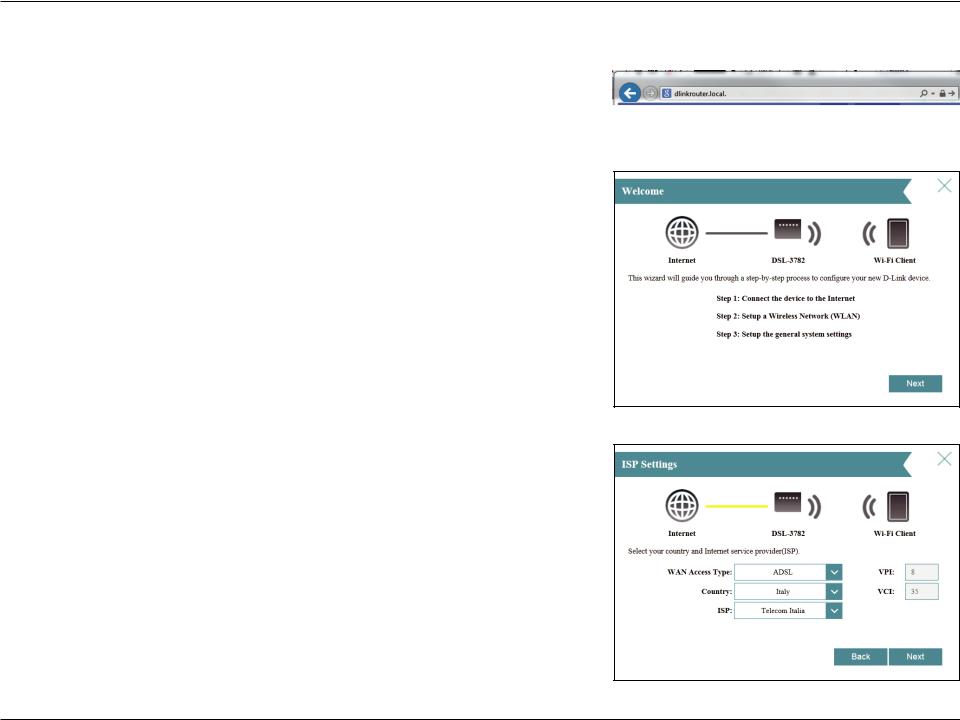
Section 3 - Getting Started
Setup Wizard
If this is your first time using the router, open your web browser and enter http://dlinkrouter.local./ in the address bar. Alternatively, enter the IP address of the router (default: http://192.168.1.1).
The wizard is designed to guide you through a step-by-step process to configure your new D-Link router and connect to the Internet. Ensure that your DSL phone cable is connected to both the router and the wall jack.
Click Next to continue.
First, you must select your WAN Access Type. The options are ADSL, VDSL, or Auto. To quickly find your ISP's settings, select your Country and ISP. The VPI and VCI values will automatically be configured.
Click Next to continue.
D-Link DSL-3782 User Manual |
13 |
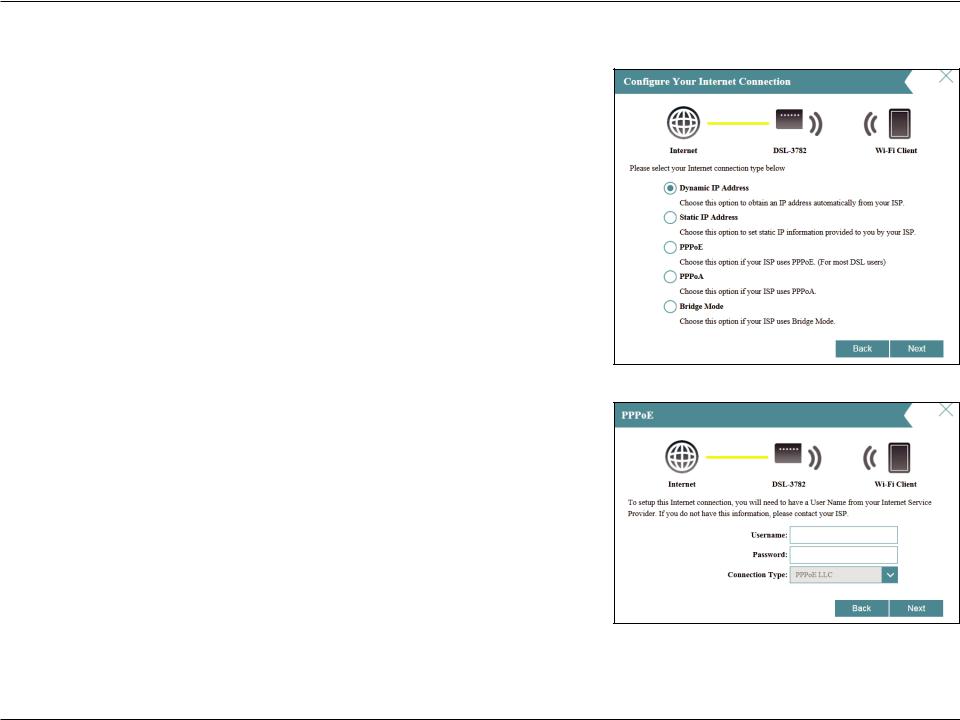
Section 3 - Getting Started
Setup Wizard (continued)
If the router cannot determine your connection type, a list of connection types to choose from will be displayed. Select your Internet connection type (this information can be obtained from your Internet Service Provider) and click Next to continue.
If the router detected or you selected PPPoE, enter your PPPoE username and password, choose the Connection Type if asked, and click Next to continue.
Note: Make sure to remove your PPPoE software from your computer. The software is no longer needed and will not work through a router.
D-Link DSL-3782 User Manual |
14 |
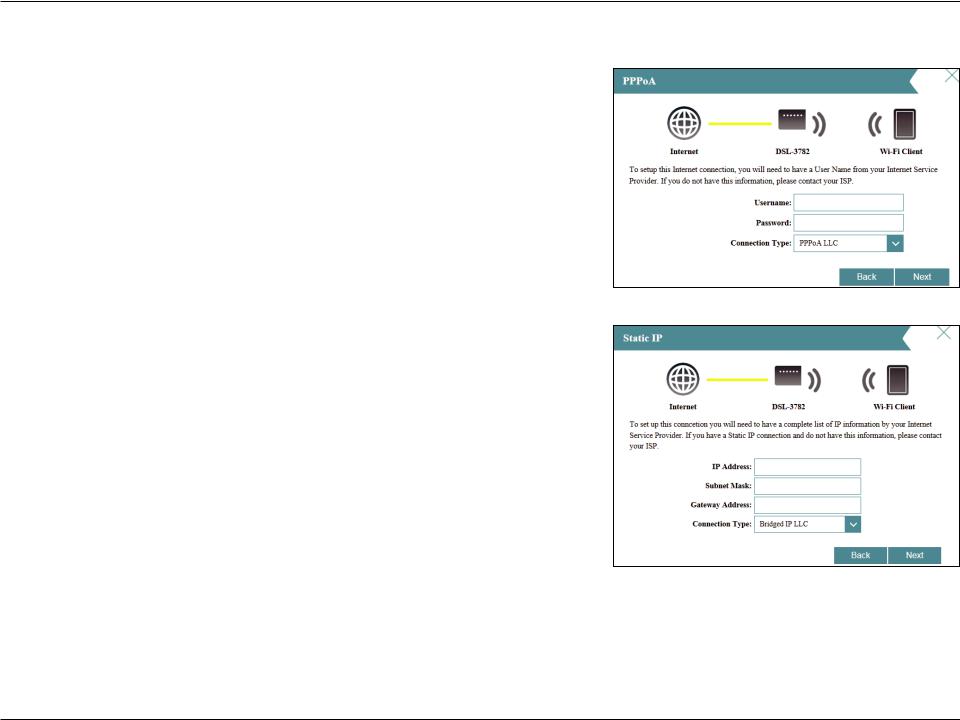
Section 3 - Getting Started
Setup Wizard (continued)
If the router detected or you selected PPPoA, enter your PPPoA username and password, choose the Connection Type if asked, and click Next to continue.
Note: Make sure to remove your PPPoA software from your computer. The software is no longer needed and will not work through a router.
PPPoA connection type is only available for ADSL connections.
If you selected Static IP, enter the IP address, subnet mask, gateway address provided by your ISP, and choose the Connection Type if asked. Click Next to continue.
D-Link DSL-3782 User Manual |
15 |
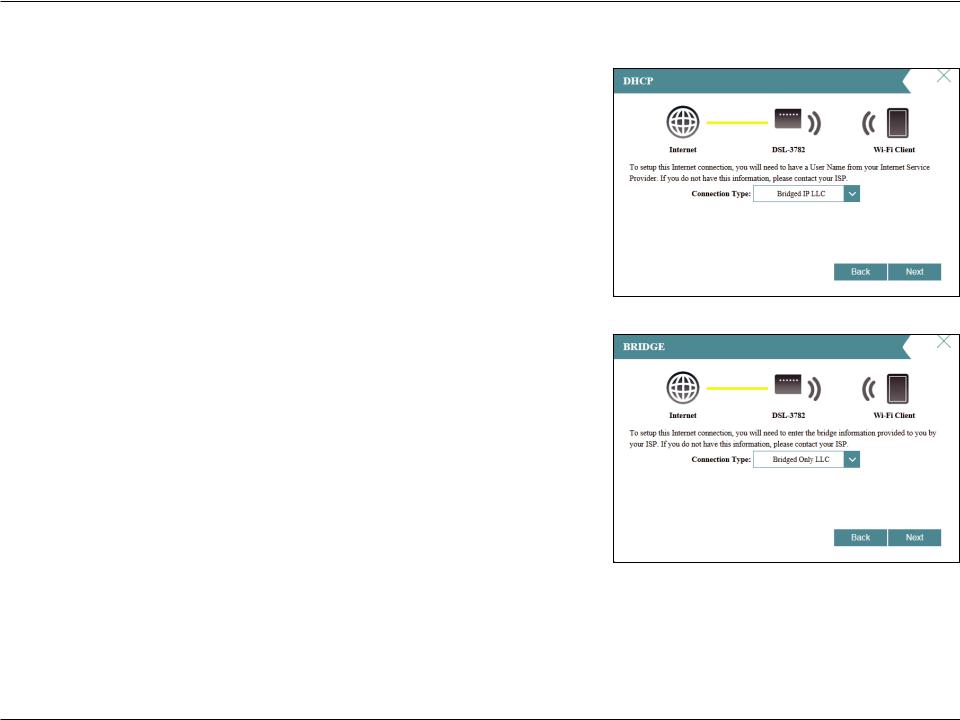
Section 3 - Getting Started
Setup Wizard (continued)
If the router detected or you selected Dynamic IP Address (DHCP), choose the Connection Type if asked. Click Next to continue.
If you selected Bridge, choose the Connection Type if asked. Click Next to continue.
D-Link DSL-3782 User Manual |
16 |
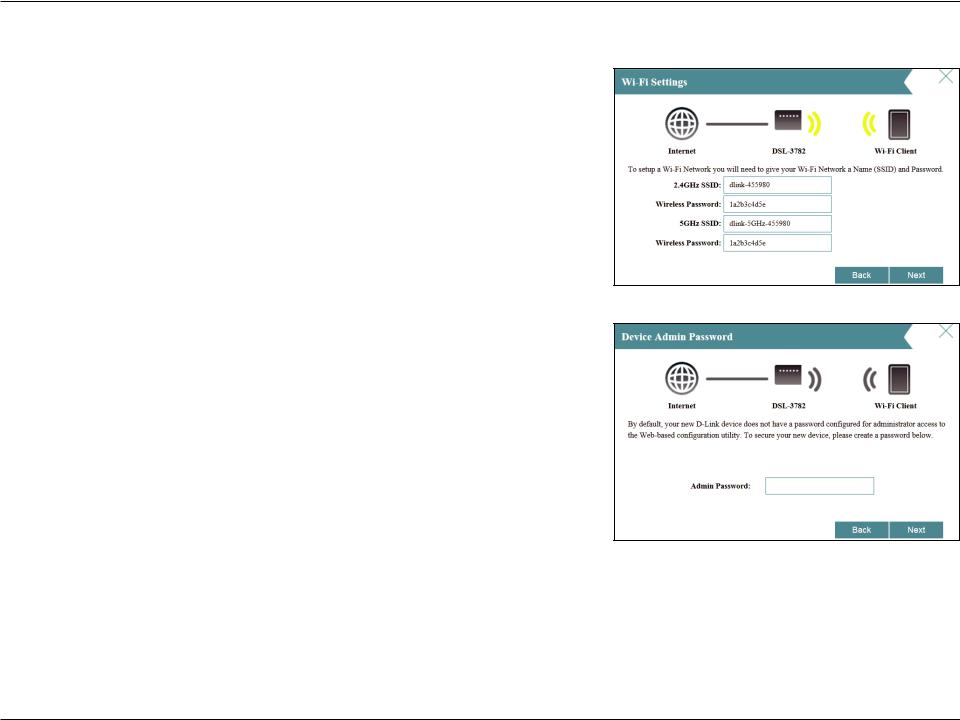
Section 3 - Getting Started
Setup Wizard (continued)
Create a Wi-Fi SSID and password for both the 2.4 GHz and 5 GHz wireless networks. The SSIDs must be between 3 and 32 alphanumeric characters in length and may include hyphens, underscores, periods, and the @ symbol. The passwords must be between 8 and 63 alphanumeric characters in length.
Your wireless clients must use these SSIDs and passwords in order to connect to your wireless networks.
Click Next to continue.
In order to secure the router, please enter a new password.You will be prompted for this password every time you want to use the router’s web configuration utility. Click Next to continue.
D-Link DSL-3782 User Manual |
17 |
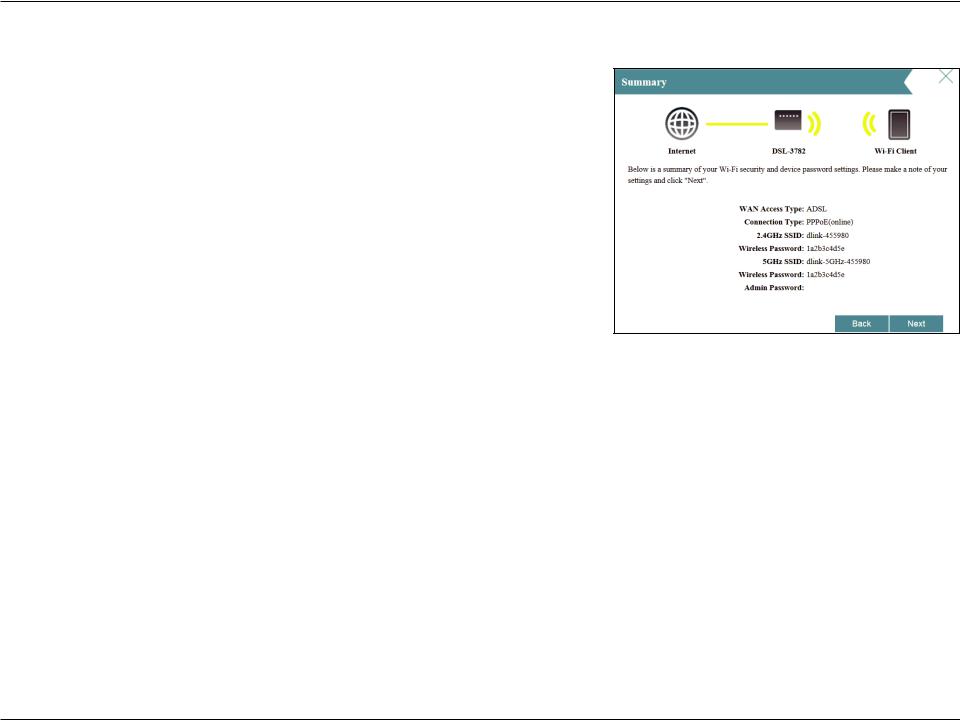
Section 3 - Getting Started
Setup Wizard (continued)
The Summary window will display your settings. Click Next if you are satisfied, or click Back to make changes to them. The wizard will close and your settings will be saved.
Congratulations, setup is complete.
D-Link DSL-3782 User Manual |
18 |
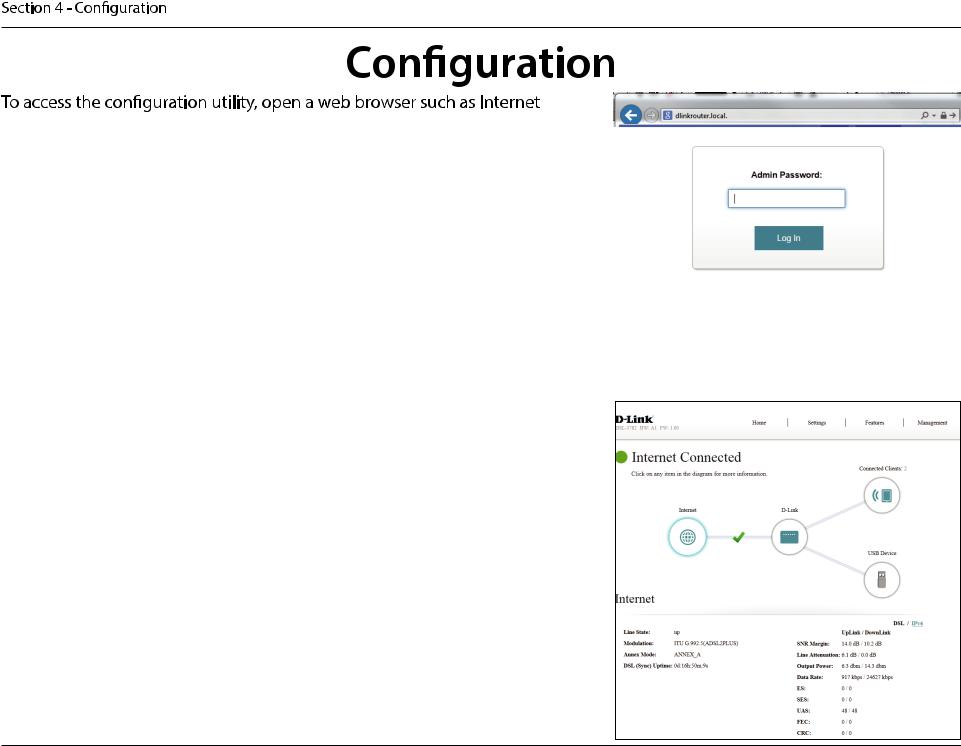
Explorer and enter http://dlinkrouter.local./
Windows and Mac users may also connect by typing the IP address of the router (by default this is http://192.168.1.1) in the address bar.
Input the default password as admin. If you previously followed the Setup Wizard (see page 13), please use the admin password you entered during the wizard. Otherwise, input default password as 'admin'. Click Log In
to proceed.
Note: If you cannot remember your password and cannot log in, press the reset button (see page 5) to restore the router to its default settings.
Home
The Home page displays the current status of the router in the form of an interactive diagram. There are four main sections: Internet, D-Link, Connected Clients, and USB Device. You can click each icon to display information about each section at the bottom of the screen. The menu bar at the top of the page will allow you to quickly navigate to the Settings and Management functions. You may quickly jump back Home at any time.
Note: The system will automatically log out after a period of inactivity.
D-Link DSL-3782 User Manual |
19 |
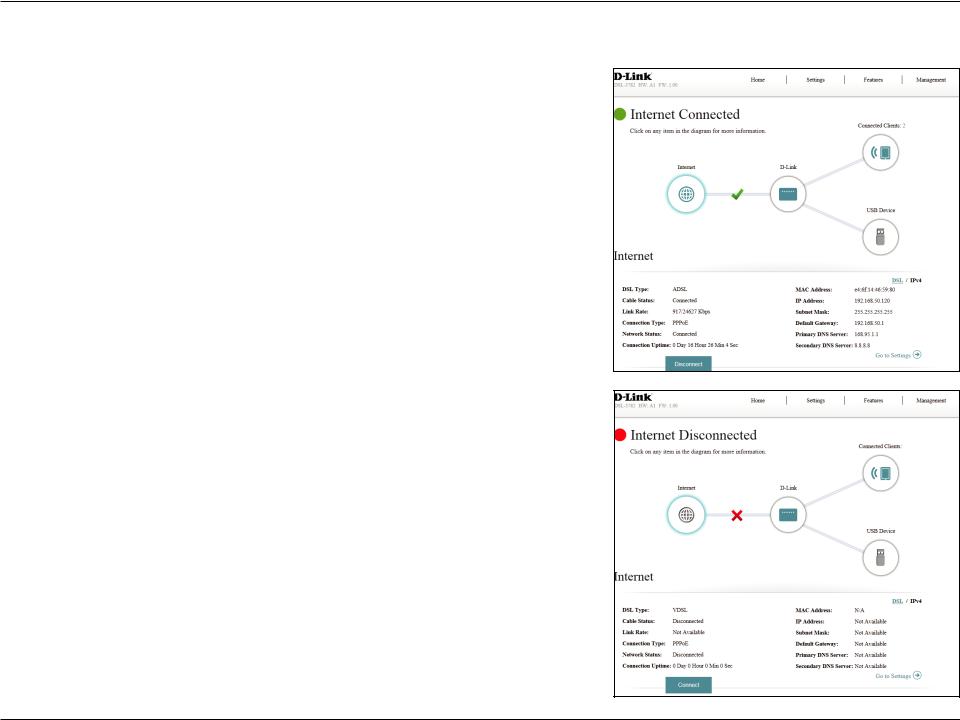
Section 4 - Configuration
Internet
To bring up more details about your Internet connection, click on the Internet icon. The Internet Connection status at the top of the diagram will reflect the status of the currently selected WAN interface.
If your Internet is disconnected, indicated by a red X, you can launch the Setup Wizard to correct the issue by clicking Wizard from the Settings menu on the bar on the top of the page.
You can see the DSL connection status and IPv4 information at the bottom of the page. Clicking the DSL button will display DSL port information.
D-Link DSL-3782 User Manual |
20 |
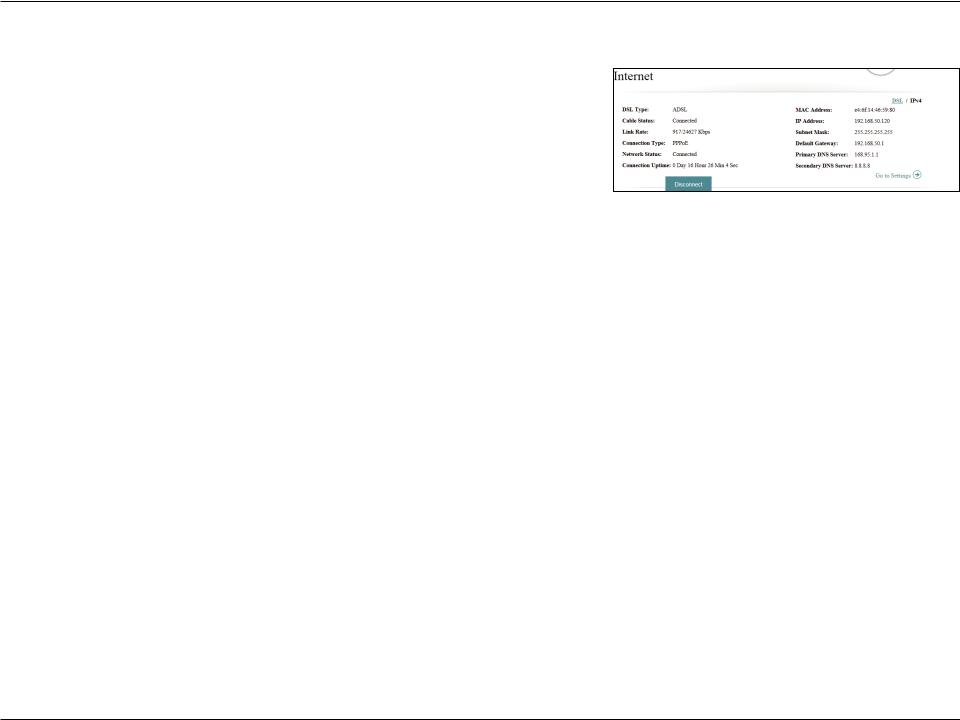
Section 4 - Configuration
IPv4
Click the IPv4 button to see the IPv4 information for the DSL interface. If you have configured your ADSL/VDSL connection to use PPPoE with On-Demand or Manual settings, you can connect to or disconnect from the Internet by pressing the Connect or Disconnect buttons.
IPv4
DSL Type: |
Displays the current DSL type, either ADSL or VDSL. |
Cable Status: |
Displays the current cable connection status. |
Link Rate: |
Displays the currently negotiated connection speed. |
Connection Type: |
Displays the network protocol used to obtain an IP address. |
Network Status: |
Displays the current network connection status. |
Connection |
Displays the amount of time the connection has been connected. |
Uptime: |
|
MAC Address: |
Displays the MAC address of this interface. |
IP Address: |
Displays the current WAN IPv4 address. |
Subnet Mask: |
Displays the current subnet mask. |
Default Gateway: |
Displays the current IPv4 default gateway. |
Primary DNS |
Displays the current primary DNS server. |
Server: |
|
Secondary DNS |
Displays the current secondary DNS server. |
Server: |
|
D-Link DSL-3782 User Manual |
21 |
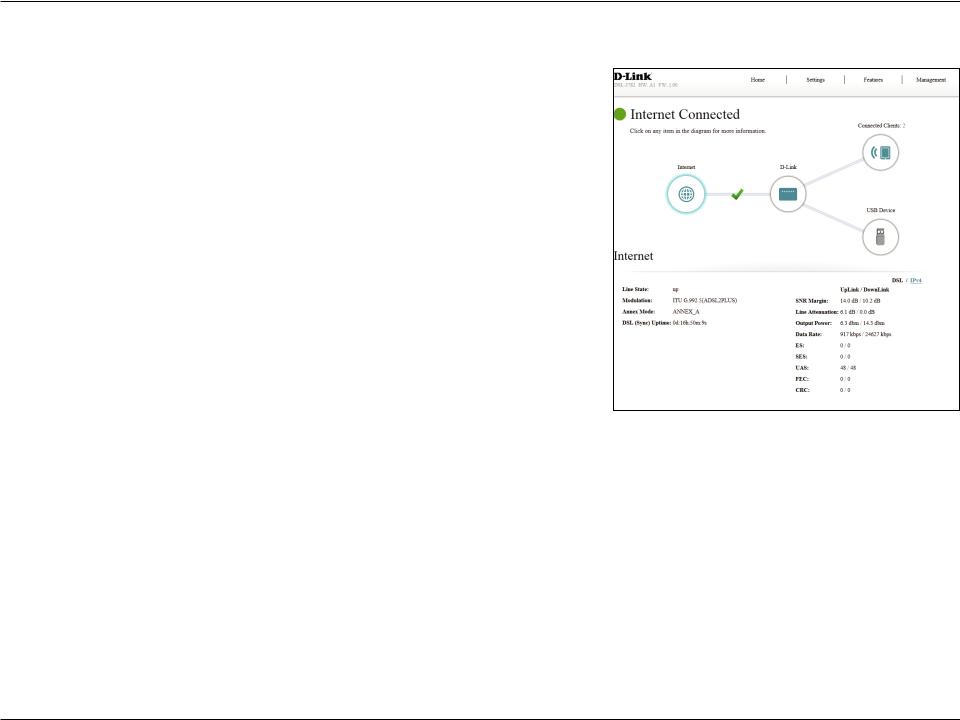
Section 4 - Configuration
DSL
Click the DSL button to see the DSL port connection information. The DSL tab displays information regarding the DSL data connection.
DSL
Line State: Displays the current status of the data link connection to your ISP.
Modulation: Displays the current DSL standard in use.
Annex Mode: Displays the current Annex mode in use.
DSL (Sync) Displays the DSL connection uptime.
Uptime:
SNR Margin: Displays the Signal-to-noise margin.
Line Attenuation: Displays the current signal attenuation.
Output Power: Displays the output power of the DSL modem.
ES, SES, UAS, FEC, These error correction counts are used for diagnostic purposes. If CRC: you are having trouble with your ISP, these values may provide useful
information for technicians.
D-Link DSL-3782 User Manual |
22 |
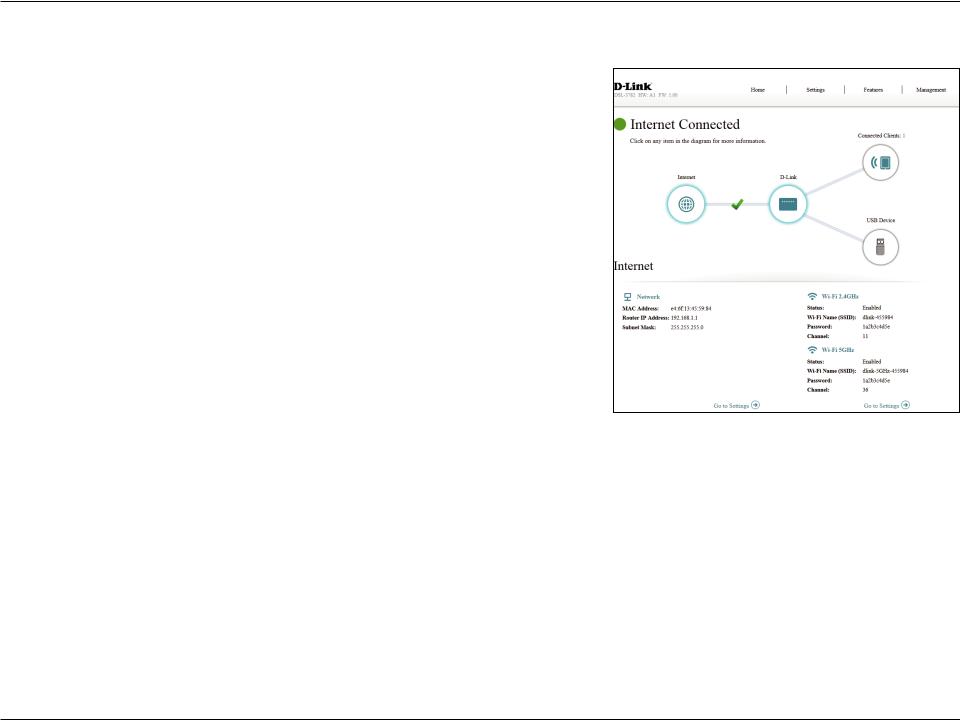
Section 4 - Configuration
D-Link
Click on the D-Link icon to view details about the router and its wireless settings.
Here you can see the router’s current wireless networks and passwords, as well as the local area network MAC and IPv4 addresses.
To reconfigure the network settings, click the Go to settings link, from the Settings menu at the top of the page, select Network. Refer to page Network on page 44 for more information.
To reconfigure the wireless settings, click the Settings menu at the top of the page, select page 36 for more information.
Go to settings link, from the Wireless. Refer to Wireless on
D-Link DSL-3782 User Manual |
23 |
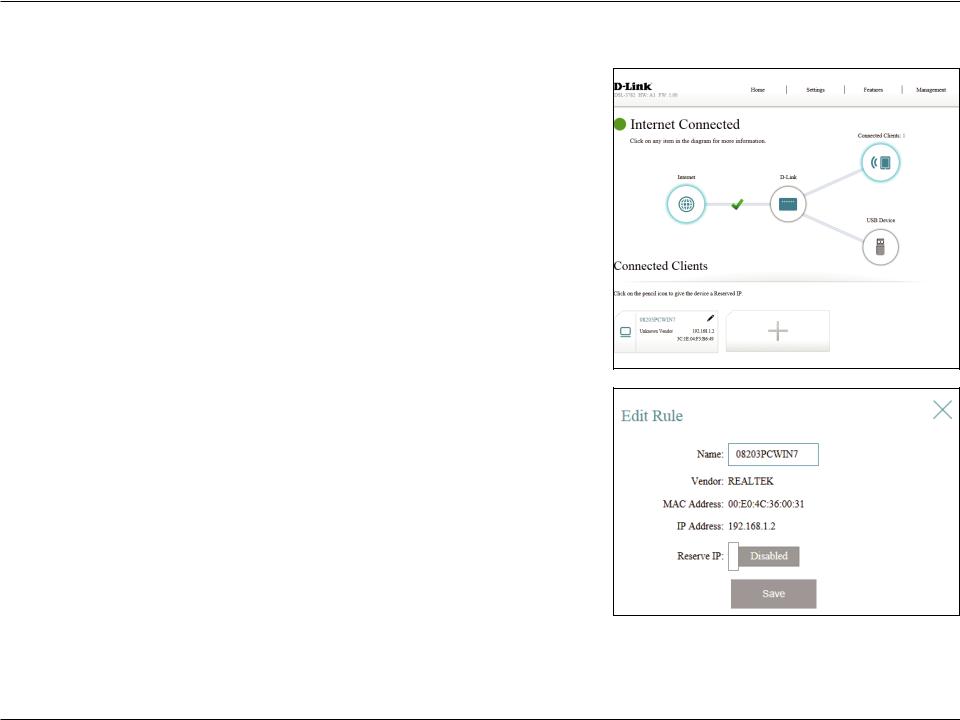
Section 4 - Configuration
Connected Clients
Click on the Connected Clients icon to view details about the clients currently connected to the router and their IP addresses.
To edit each client’s settings, click the pencil icon on the client you want to edit.
Edit Rule
Name: |
Enter a custom name for this client. |
Vendor: |
Displays the vendor of the device. |
MAC Address: |
Displays the MAC address of the device. |
IP Address: |
Enter a specific IP address for this client if Reserve IP is enabled. |
Reserve IP: |
Enable to reserve this IP address for this client. |
|
Click Save when you are done. |
D-Link DSL-3782 User Manual |
24 |

Section 4 - Configuration
USB Device
Click on the USB Device icon to view details about the currently connected USB device, DLNA Media Server, SharePort, and Windows File Sharing settings.
If you have a USB device connected, you can see its name and how much free space it has.
To safely disconnect your USB drive, click Unmount.
To configure your USB settings, click Go to settings and refer to page USB Device on page 25 for more information.
For information on how to access your USB drive from a Windows-based PC refer to Connect and Share a USB Storage Device on page 70.
D-Link DSL-3782 User Manual |
25 |
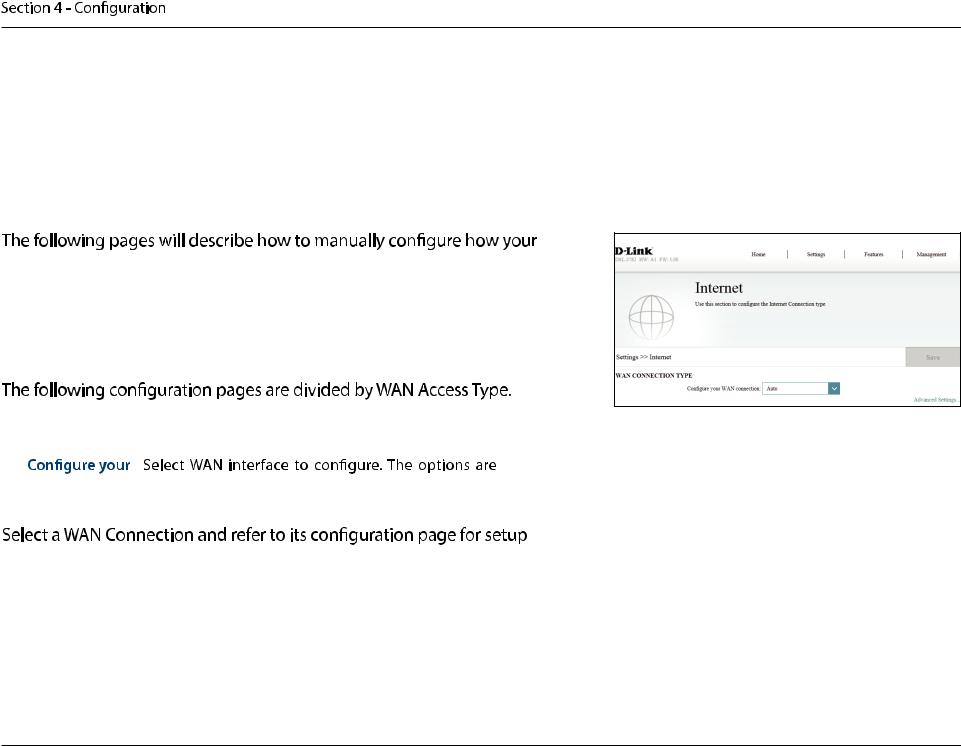
Settings
Wizard
To access the Setup Wizard page, click Wizard from the Settings menu on the bar on the top of the page. This is the same  Setup Wizard on page 13 for more information.
Setup Wizard on page 13 for more information.
Internet
DSL-3782 connects to the Internet. To access this page, click Internet from the Settings menu on the bar on the top of the page. The DSL-3782 supports multiple WAN connection types and WAN failover. We recommend setting up Internet WAN connections one at a time, Save  the connection works before returning to this section to add additional WAN connections.
the connection works before returning to this section to add additional WAN connections.
WAN CONNECTION TYPE
Auto, ADSL,
WAN Connection: or VDSL .
information.
For ADSL, refer to ADSL on page 27. For VDSL, refer to VDSL on page 29.
Auto 
D-Link DSL-3782 User Manual |
26 |
